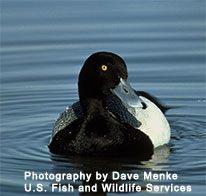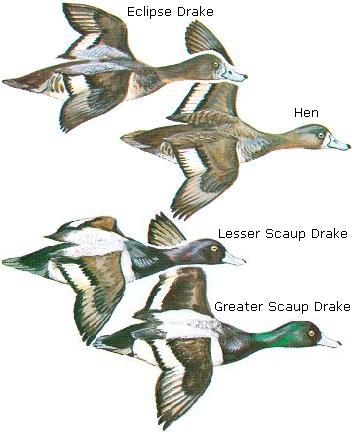Wildlife - Species

Species Specific Regulations
Lesser Scaup
Licenses: Hunting License required. Migratory Bird Hunting and Conservation Stamp (Federal Duck Stamp) that is validated by the hunter signing the stamp in ink across the face of the stamp
Limits: Please see Migratory Bird Regulations for any game zones restrictions or Limitations.
Lesser Scaup (Aythya affinis)

Description
Greater and lesser scaups appear nearly identical in the field but they have some subtle differences. Greater scaups have a light band near the trailing edges of the wings runs almost to the tip, but in lesser scaups it runs only about half way. The greater scaup is also slightly larger and has a flatter top of the head.
Average Size
Lesser scaups have an average length of 17 inches and an average weight of 1 7/8 pounds.
Range
Lesser scaups are found in all 4 flyways, but the majority of birds migrate through the Central and Mississippi. In South Carolina lesser scaups are winter residents to the Coastal Plain and Piedmont regions.
Preferred Habitat
In the summer months lesser scaups are found in fresh and brackish semi-permanent wetlands, lakes with emergent vegetation, and shallow river impoundments. In the winter months they are found along the coasts of lakes, reservoirs, and fresh or brackish coastal bays and estuaries. .
Typical Flock Pattern

Wings

Food Habits
The diet of the lesser scaup is mainly composed of aquatic invertebrates such as insects, crustaceans, and mollusks. They also consume seeds and the vegetative parts of aquatic plants.
Reproduction
Lesser scaups are one of the last ducks to form pair bonds during late spring migration. Once on the breeding grounds the female builds a nest on, or near, land in areas with tall vegetative cover. The hen creates a scrape in the ground and over time adds grass and down. She lays 6-14 pale to dark olive buff eggs.
Sound
Drakes makes a purr., hens are silent.
Behavior
- Migrate late, sometimes just before freezeup.
- Flock movements are rapid, often erratic, usually in compact groups.
- Walks with greater ease than other diving ducks.
- Do not defend territories, and tend to have small overlapping home ranges.
- Form large flocks on wintering grounds, sometimes up to 500,000 ducks.
Citations, Publications and Literature
U.S. Fish & Wildlife Service, Federal Duck Stamp Office Presents: North American Waterfowl (Adobe PDF file)
Austin, Jane E., Christine M. Custer and Alan D. Afton. 1998. Lesser Scaup (Aythya affinis), The Birds of North America Online (A. Poole, Ed.). Ithaca: Cornell Lab of Ornithology; Retrieved from the Birds of North America Online
South Carolina waterfowl hunters 16 and older are required by state law to obtain a state migratory waterfowl permit and Migratory Game Bird permit. Both permits must be in the hunter's possession while hunting or transporting legal waterfowl. A state waterfowl permit is included with the Lifetime Senior, Lifetime Gratis and Disability Licenses. S.C. residents who hold a Lifetime Senior or Lifetime Gratis License are not required to have a Migratory Game Bird permit.
National Migratory Bird Harvest Information Program (HIP)
The waterfowl permits and HIP permits are available from select DNR offices and from hunting and fishing license agents.
